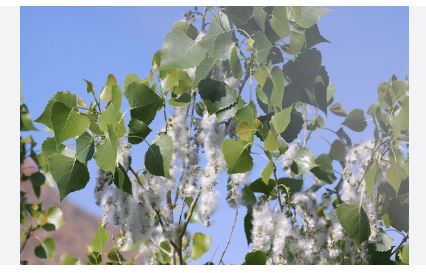
Populus deltoides, commonly known as the Eastern Cottonwood or simply Cottonwood, is part of the Populus genus within the Salicaceae family, which also includes willows. This species is named ‘deltoides’ due to its triangular or deltoid-shaped leaves. It’s a fast-growing, deciduous tree known for its cotton-like seeds that are dispersed by wind.
The Eastern Cottonwood is native to North America, with its range extending throughout much of the eastern and central United States and into southern Canada. It covers areas from Quebec and Ontario in Canada, south to Florida, and west to the Great Plains, including states like Texas, Oklahoma, Kansas, Nebraska, and into parts of Montana. It thrives in riparian zones, along riverbanks, and in floodplains, where it can access ample water, but it’s also found in upland areas.
Historically, Populus deltoides has been significant for both Native American tribes and European settlers. Indigenous peoples used its bark for medicinal purposes, particularly for pain relief and wound healing. The wood was utilized for construction and crafting tools due to its lightweight yet strong nature. Settlers valued it for its quick growth, using it for lumber, pulpwood, and as a source of shade due to its vast canopy. The tree’s name reflects its method of seed dispersal, where in spring, female trees release cottony seeds, creating a ‘snow’ effect, which has been both a natural spectacle and sometimes a nuisance in urban areas. Its ecological role in stabilizing riverbanks and providing habitat is considerable.
The Eastern Cottonwood is adapted to USDA Hardiness Zones 2 through 9, showcasing its wide range of climatic adaptability, from the cold winters of Canada to the warm, humid conditions of the southern U.S. Its lifespan varies, typically living 70 to 100 years, though some trees can reach 200 years under optimal conditions. Its rapid growth rate can lead to a shorter life span compared to slower-growing species, but this also means it’s an effective colonizer of disturbed areas, contributing to succession in ecosystems.
Eastern Cottonwood (Populus deltoides): Characteristics
- Growth Habit: Known for its fast growth, it can reach heights of 70 to 100 feet with a broad, spreading crown, making it one of the largest native trees in its range. It often has a single, straight trunk.
- Leaves: Leaves are simple, triangular (deltoid), with a glossy green upper surface and a paler underside. They have a flat petiole that causes the leaves to flutter in the wind, creating a characteristic rustling sound.
- Bark: Young trees have smooth, greenish bark, which becomes deeply furrowed, thick, and gray to dark brown as the tree matures, providing winter interest and habitat for wildlife.
- Root System: Has an aggressive root system that can include both deep taproots and extensive lateral roots, which are beneficial for soil stabilization but can be problematic near structures or utilities.
- Flowers: Produces catkins; male catkins are longer and yellow, while female catkins are shorter and green. Flowering occurs in early spring before the leaves emerge.
- Seed Dispersal: Female trees produce capsules that release seeds with cottony fibers, facilitating wind dispersal. This “cotton” can be seen floating in large quantities in late spring to early summer.
- Adaptability: Highly adaptable to various soil types but prefers moist, well-drained soils, making it common along rivers, streams, and in floodplains. It’s also drought-resistant once established.
- Pollinator Attraction: While not primarily a nectar source, its catkins provide early pollen for bees and other early-season pollinators.
- Ecological Role: Plays a crucial role in riparian ecosystems, offering habitat, shade, and food for numerous species of wildlife. Its wood and leaves support a variety of insects, which in turn feed birds and other animals.
- Longevity and Decay: Although it grows quickly, it’s relatively short-lived compared to some trees, with a lifespan often up to 70-100 years. Its wood is prone to decay, making it less ideal for long-term structural uses but valuable for pulpwood and other short-term applications.
Eastern Cottonwood (Populus deltoides): Cultivation
Site Selection
Select a location with full sun, as Cottonwood thrives in open, sunny areas. It’s particularly suited to riparian environments or areas with consistent moisture but can grow in upland sites as well.
Soil Preparation
Prefers deep, well-drained, moist soils but is adaptable to a range of soil types, including clays, loams, and sands. Ensure good drainage to prevent root rot, especially in less ideal conditions.
Planting
Plant in spring or fall. Due to its large mature size, space trees well apart, about 50 to 70 feet from structures or other trees. Dig a hole twice as wide as the root ball but no deeper, keeping the root collar at ground level.
Watering
Water deeply after planting to establish roots. Once established, it’s moderately drought-tolerant but will benefit from supplemental watering in dry periods, especially when young.
Mulching
Apply mulch around the base to retain soil moisture, suppress weeds, and regulate soil temperature. Keep mulch away from the trunk to avoid moisture accumulation that might cause rot.
Fertilization
Fertilize sparingly if at all, as Cottonwood is adapted to nutrient-poor soils. If soil is very poor, a balanced, slow-release fertilizer in early spring might be beneficial.
Pruning and Maintenance
Prune in late winter or early spring to remove dead or damaged branches, promote a strong structure, or manage size. Be aware of its fast growth and potential for suckering.
Pest and Disease Management
Watch for pests like cottonwood borers or leaf beetles and diseases such as canker or leaf spot. Good air circulation and avoiding overwatering can help prevent disease. Use integrated pest management strategies.
Propagation
Propagates easily from seeds, cuttings, or suckers. Cuttings from young, vigorous branches in late winter or early spring are particularly effective for cloning desired traits.
Winter Care
In its hardiness zones, no special winter care is needed. Cottonwoods are hardy to cold but can suffer from branch breakage in heavy snow or ice. Prune as needed after such events.